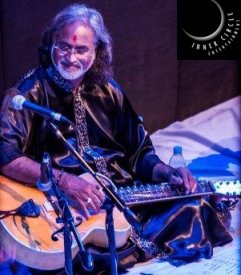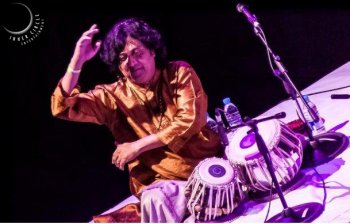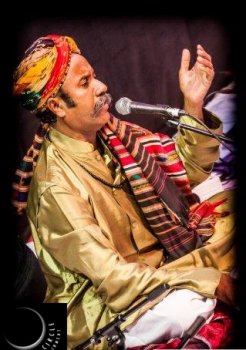
|   |

|   |
Ragas of the desert - Verushka Pather e-mail: verushkamood@hotmail.com June 26, 2013 Ragas of the Desert was a meeting of the masters inspired by the vast expanses of the Thar Desert of Rajasthan, India. The spiralling sounds of the Mohan Veena intertwined with the vocal harmonies of the Manganiyars, the melodies of Kamancheh, and the ecstatic rhythms of the tabla, dholak and the khadtal, like a long distance message passing through the vast desert. For weeks I waited in anticipation of this extraordinary recital as Inner Circle Entertainment has set a standard and you are guaranteed a phenomenal experience with their programs. Ragas of the Desert, as the name suggests, brings with it the feeling of love, unspoken silence, longing and searching beyond, all the emotions I felt when sitting in the perfect venue, The Lyric Theatre, Johannesburg on June 9. Because of brilliant publicity and advertising there was a unique multi-cultural gathering of art lovers all getting to their seats in eager anticipation.  Pt Vishwa Mohan Bhatt I looked up and onto the stage walked a regal and unassuming soul. From his commanding presence with his silver mane, clad in an elegant black silk kurtha, one immediately recognized Pandit Vishwa Mohan Bhatt. His first words when seated was, “I have travelled to 81 countries and have anxiously waited for this invite to come to South Africa. I am very happy to be here with you tonight.” Panditji patiently shared with us a brief history of Indian classical music and the characteristics of a raag. That it is like a scale, varying at every instant with improvisations and spontaneously created for the moment. Ragas are created for meditation, purification and spirituality. Insisting that he wanted the audience to be a part of his recital to understand and enjoy every part, he shared the 3 aspects of a classical recital, raised his hands together and asked us to bless him as he continued. The perfect night for a mesmerising raag was Maru Bihag, the chosen raag for Panditji’s composition, filled with emotions of shringar or love and reminiscent of the captivating beauty of nature. This was a glimpse of Panditji's virtuosity, his knowledge and this great gift of inventing a classical music instrument. The Mohan Veena is a highly modified concord arch top guitar played on the lap. It is a loud instrument that is able to resonate through low amplification. It captures the soul of a veena or sitar with a more modern, bluesy or jazz effect. Watching Panditji's superb control and mastery of speed he is undoubtedly one of the most intuitive, expressive and versatile artist that has graced our stage in South Africa.  Pt Subhen Chatterjee The interaction with Panditji and Subhen Chatterjee on tabla was phenomenal. Their perfectly synchronised tihais and their unified, infectious interaction on stage was a pleasure to experience. Subhen Chatterjee is an excellent exponent of the arts and his flamboyant character makes him an artiste loved by all. He certainly goes out of his way to make sure he pleases his crowd. Pt. Vishwa Mohan Bhatt continued using Maru Bihag to depict different emotions and scenes. A gamak portraying a female’s anger could be clearly felt and visualised and then, she is now pleased and happy, the raag entrancingly moves from the harsh deep notes to a subtle intense note oozing with love. Panditji spoke about his life in Jaipur and his inspiration from the birds and the peacocks and mimicked the exact sounds as he reminisced. The question and answer on tabla and Mohan Veena was superb. This was disrupted by poor sound, disappointing for the Lyric Theatre but the artistes tried to manage with disturbances and poor settings of the amplification.  Pops Mohamed The second part of the recital was collaboration with Pops Mohamed who specialises in playing indigenous instruments from Africa. From the brief introduction and seeing him on stage and his special aura, I believe that he lives by what he says and plays, that the millennium is actually going back into the past to move into the future. He welcomed us on a mystical journey, where playing the Birimbau from the Kalahari Desert allows us to journey together looking for the same answers. This remarkable instrument is used by the Bushmen when collecting honey. The bees tune into the frequency of the instrument and are pacified. This allows the hunters to collect from the hive. So too, in our world one is calmed and pacified by intense, intimate sounds of classical music to minimize the sting. His sharing of his talent on the amazing instruments was phenomenal; he created sounds from the desert, wind, birds and the movement of sand. The collaboration was nothing short of outstanding. The fusion revealed a rare, often transcendental beauty as the two artistes gently and intuitively found common ground. This in front of us is our future, looking beyond classical, contemporary, Indian, African, vintage and modern, is just the creation of music and this only happens when one shares from heart to heart. The dedication to the father of our nation Nelson Mandela was touching and applauded by all. Panditji sincerely expressed his concern and wished that the emotions and blessings from the raag Kirwani travels to Madiba for a safe and speedy recovery. What an incredible composition, so endearing, comforting and filled with sentiments of love and devotion. A perfect raag set at the perfect time and again brilliant sharing from Panditji and Pops Mohamed.  Manganiyar After this melancholy mood, I was amazed by the astounding applause and welcome for the Manganiyars, an exclusive community of musicians from vibrant and intriguing Rajasthan. The simplicity of their tradition and modest display of their art and culture gave us a glimpse of the essence of Rajasthan. They were a treat to watch and enjoyed playing for us as much as we enjoyed listening to them. They began with a traditional song Kesariya Balam in raag Maand, meaning welcome to our village. The maestro was seated comfortably with simple but brilliant village musicians sharing music, sharing their legacies and sharing their souls.  Pt Vishwa Mohan Bhatt with Manganiyars Panditji then went on to tell us that it is only the 7 notes in music that is universal and unites the entire world. His Grammy Award title A Meeting by the River, an enchanting piece in raag Tilak Kamod and Maand composed with Ry Cooder was unplanned and unrehearsed. They met one hour before the recording to create magic. A twilight raag filled with love and compassion, one was able to visually experience the versatility, fluidity and flexibility of the raag by the variations in emotions and the elaborate improvisations within its scale. And just listening to these varied emotions, I could not help myself but be taken back to the banks of the Yamuna, the ordained meeting place of Radha and Krishna. Panditji composed this piece as a celebration of love, friendship and sharing from one’s heart. He captivated the audience by insisting on our participation and then concluded with a vibrant finale Nimbooda. The alaap was magnificent and exuded Panditji's expressive bhava. This is a popular folk song that got everyone tapping their feet, throwing their hands up and really if it was not the Lyric, I am sure we would have gotten up to dance. Congratulations to Nisaar Pangarker and the Inner Circle team for not just planning to host a program but travelling around the world to especially choose the best program to suit our times, our audience and what will have a positive impact on all who attend. To Pt. Vishwa Mohan Bhatt, Subhen Chatterjee, The Manganiyars and Pops Mohamed, thank you for sharing your art and allowing us to have a glimpse of your soul. Verushka Pather is a Bharatanatyam dancer based in South Africa. |